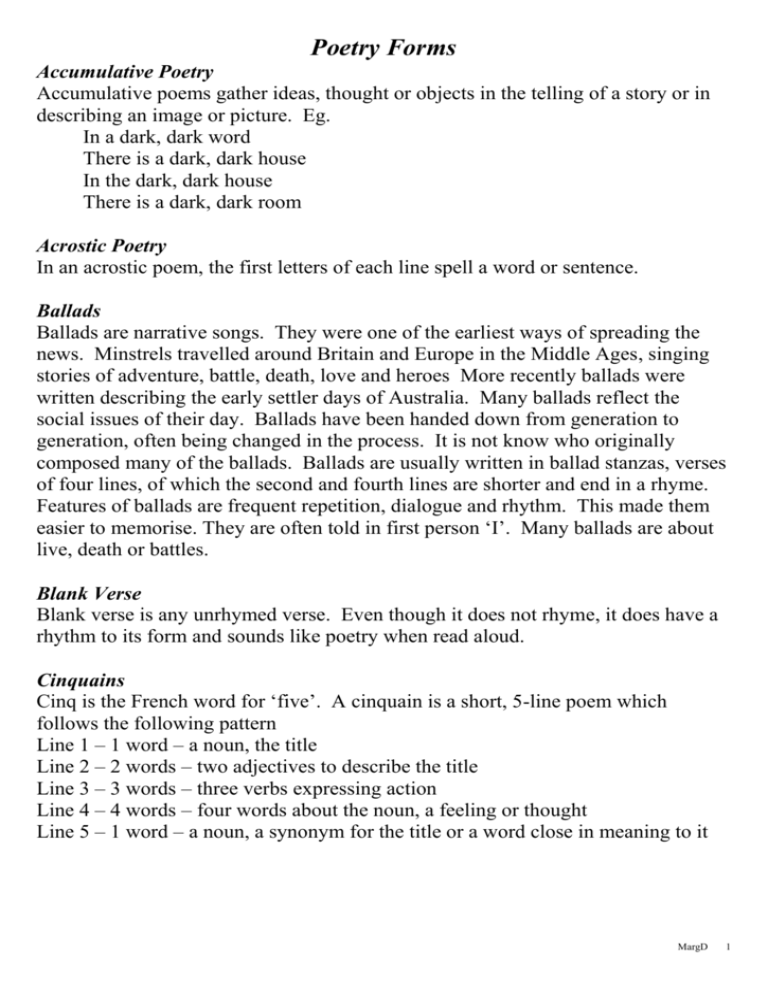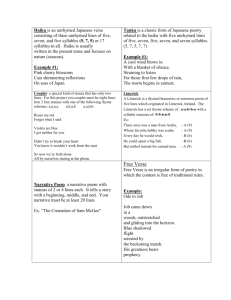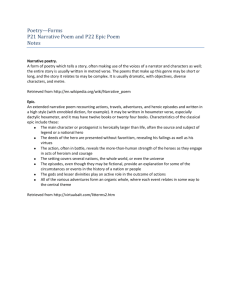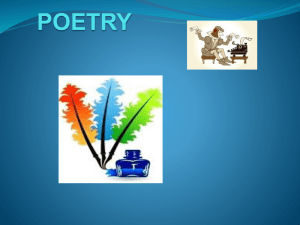Acrostic Poetry - MargD Teaching Posters
advertisement

Poetry Forms Accumulative Poetry Accumulative poems gather ideas, thought or objects in the telling of a story or in describing an image or picture. Eg. In a dark, dark word There is a dark, dark house In the dark, dark house There is a dark, dark room Acrostic Poetry In an acrostic poem, the first letters of each line spell a word or sentence. Ballads Ballads are narrative songs. They were one of the earliest ways of spreading the news. Minstrels travelled around Britain and Europe in the Middle Ages, singing stories of adventure, battle, death, love and heroes More recently ballads were written describing the early settler days of Australia. Many ballads reflect the social issues of their day. Ballads have been handed down from generation to generation, often being changed in the process. It is not know who originally composed many of the ballads. Ballads are usually written in ballad stanzas, verses of four lines, of which the second and fourth lines are shorter and end in a rhyme. Features of ballads are frequent repetition, dialogue and rhythm. This made them easier to memorise. They are often told in first person ‘I’. Many ballads are about live, death or battles. Blank Verse Blank verse is any unrhymed verse. Even though it does not rhyme, it does have a rhythm to its form and sounds like poetry when read aloud. Cinquains Cinq is the French word for ‘five’. A cinquain is a short, 5-line poem which follows the following pattern Line 1 – 1 word – a noun, the title Line 2 – 2 words – two adjectives to describe the title Line 3 – 3 words – three verbs expressing action Line 4 – 4 words – four words about the noun, a feeling or thought Line 5 – 1 word – a noun, a synonym for the title or a word close in meaning to it MargD 1 Circular Poetry Circular poems commence a story at a point, reach a climax, then return to the beginning. Concrete Poetry (Shape Poems) In concrete poetry the shape of the poem as well as the language used in the poem contributes to its meaning. The visual impact of the poem is as important as the words. You need to see as well as hear the poem to fully appreciate it. Descriptive Poetry Descriptive poetry is written, not to tell a story, but to describe a scene, a mood, a feeling, an animal, a person or an experience. Some poems not only depict a scene but also create an atmosphere. The features of descriptive poetry are imagery and descriptive language. There are poetic devices such as onomatopoeia, alliteration, personification, similes and metaphors which help the poet to write descriptively. Free Verse Free verse is the expression of a poet’s ideas, thoughts and feelings without the restrictions of formal poetry such as rhymes and rhythms. It can be written like ordinary speech. The poet’s ideas are written as if they were being spoken out loud. The length of the lines in the poem varies according to what the poet is saying. Haiku Haiku is a Japanese verse form dating from the fourteenth century. It has three lines with seventeen syllables. The first and third lines have five syllables and the second line has seven syllables. Traditional Japanese Haiku refers to a season, either directly or indirectly, for example, a frog represents spring and a cicada represents summer. The different moods of the seasons in Japan are reflected in the poetry. It shows the loneliness found in nature. It captures one moment in time. Haiku appears simple but has hidden depth. It appeals to the reader’s imagination. Limericks Limericks were first devised at Irish feasts many years ago and got their name form the Irish town of Limerick. They are nonsense or humorous verses. They have five lines with lines one, two and five rhyming and lines three and four rhyming. They also have a regular rhythm with lines one, two and five having eight or nine syllables and lines three and four having five or six syllables. The last line contains the joke or surprise twist to the verse. MargD 2 Narrative Poetry Narrative poems tell a story. The story is more easily remembered by the listener or readers because it is told in verse. Two features of narrative verse are definite rhythm and rhyme. They help the story to flow at a fast pace. A third feature of narrative poems is imagery. Imagery is painting a picture with language. it enables the listener or reader to visualise the story. It appeals to the senses of sight, sound, touch, smell and taste. Narrative poems are often very long. Quatrains Quatrains are four-line poems or stanzas. These may have an ABAB or AABB rhyming pattern or only the second and fourth lines may rhyme. Tongue Twisters Tongue Twisters are difficult to say because of their word construction. They involve the use of repeated letters and sounds (alliteration) and the changing of letters to give words another meaning. MargD 3







